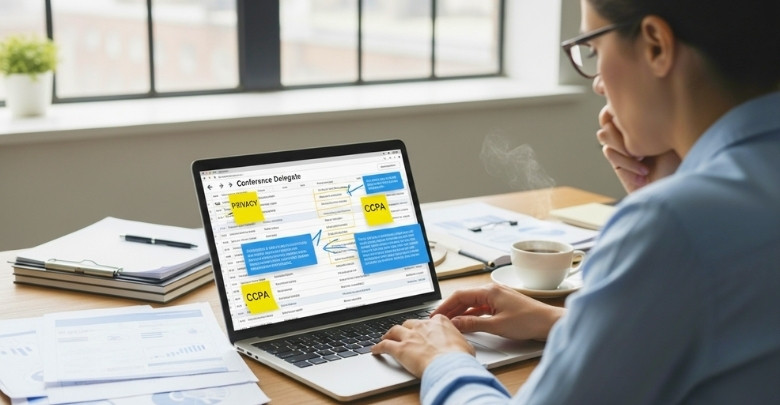Conferences are more than just sessions and speeches; they’re about people connecting and exchanging ideas. That’s where the importance of a delegate list becomes clear. It keeps everything organized, helps participants meet the right people, and ensures the event runs smoothly from start to finish. Now you may ask, what is a Conference Delegate List?
A conference delegate list is a document that includes attendees’ names, job titles, organizations, and contact details. It helps event organizers manage planning, communication, and networking. Delegates also use it to identify contacts and schedule meetings. The list supports both event logistics and professional connection-building.
Would you like to know who uses this list, how it’s prepared, and why it matters so much? If yes, then keep reading because this article explains every important detail about conference delegate lists in a clear and simple way.
What is a Conference Delegate List?
A conference delegate list is a document that shows the people who will attend an event or conference. It usually includes each person’s name, organization, job title, and contact details. This list helps everyone involved in the event stay connected, communicate easily, and manage planning tasks better. Let’s take a look at the main points that explain its meaning and purpose.

Basic Meaning
A conference delegate list is like an attendance record for an event. It contains the names and details of people who have registered to take part. It helps organizers keep track of attendees and makes it easier to communicate with them before, during, and after the event.
Important Information Included
Details typically listed include full name, organization, job title, email address, and phone number. In some cases, the country or region of each attendee is also mentioned. Keeping all this information in one place helps streamline coordination and make communication much easier.
Purpose of the Delegate List
Serving as a key organizational tool, the delegate list helps event planners manage logistics efficiently. It supports tasks like preparing name badges, arranging seating, sending updates, and coordinating follow-ups. This structured approach ensures participants are properly connected for sessions and discussions.
Helps in Networking
A delegate list helps attendees meet the right people. Before or during the event, they can look through the list to find others with similar interests or business goals. For example, those attending upcoming conferences in Canada can use the delegate list to plan meetings and build useful professional connections.
Supports Event Planning
For organizers, the delegate list is a planning tool. It helps them know how many people will attend, what kind of audience they have, and how to arrange logistics like meals, seating, and materials. It also helps in sending thank-you notes or post-event surveys afterward.
How is a Conference Delegate List Prepared?
Creating a conference delegate list takes careful planning and attention to detail. It starts with collecting attendee information and ends with a verified and organized list ready for use during the event. The process ensures that the event runs smoothly and everyone’s details are accurate and up to date. Now, let’s look at the step-by-step process of preparing a conference delegate list.
Step 1. Registration of Attendees
The process begins when participants register for the event. They usually fill out an online form or sign up through an event website. This form collects important details such as name, organization, job title, and contact information. All these entries are stored in a database for further processing.
Step 2. Verification of Details
After registration, the details are checked to make sure everything is correct and complete. Event teams verify email addresses, job titles, and organization names. This helps avoid mistakes like duplicate entries or missing contact details. Verification ensures that the final delegate list remains reliable and professional.
Step 3. Sorting and Categorizing
Once all information is verified, the data is sorted into useful categories. This may include grouping delegates by organization, country, or role. Sorting makes it easier for organizers to manage seating plans and helps attendees identify others they might want to connect with during the event.
Step 4. Use of Event Management Software
Modern event management tools make the whole process much faster and easier. These software programs collect, verify, and organize attendee data automatically. They also help update the list in real time, saving time and reducing errors, especially in large conferences with hundreds of participants.
Step 5. Finalizing the List
After sorting, the delegate list is reviewed one more time to confirm accuracy. The final version is formatted neatly and shared with event staff, speakers, and sometimes attendees. It’s often printed for registration desks or shared digitally to help everyone access attendee details easily.
Preparing a conference delegate list is a structured process that combines careful data handling with smart tools. When done correctly, it ensures that every part of the event runs smoothly and that both organizers and attendees have the information they need to connect and participate effectively.
Who Can Access the Delegate List and How to Use It?
A conference delegate list holds important information about attendees, so not everyone can access it freely. Access depends on the person’s role in the event. Once shared, the list should be used correctly to help with communication, networking, and event planning. Now, let’s look at who can access it and how it should be used properly.
Who Can Access the Delegate List
Event Organizers
Organizers have complete access to the delegate list. They use it to manage attendee records, send event updates, and handle logistics like seating, materials, and name badges. It helps them stay organized and communicate with all participants easily.
Speakers and Panelists
Speakers and panelists may get a limited version of the list. This helps them know who will attend their sessions so they can adjust their content or examples. It also lets them connect with professionals who share similar interests.
Sponsors and Partners
Sponsors and event partners often access parts of the list to find attendees who match their target audience. They use it to plan promotions, follow up after the event, or explore partnership opportunities while keeping privacy rules in mind.
Attendees
Sometimes, attendees receive a shortened version of the delegate list with only names, organizations, and designations. This helps them identify and connect with other participants for business discussions or networking during and after the event.
How to Use the Delegate List
For Communication and Coordination
The list helps in sending invitations, reminders, and thank-you messages. Organizers use it to communicate schedules, session changes, and other important updates before and during the event.
For Networking
Attendees can use the delegate list to find people they would like to meet. By checking job titles or organizations, they can plan conversations or collaborations, making networking more meaningful and targeted.
For Post-event Follow-up
After the event, the delegate list helps organizers and participants stay in touch. It’s used to send post-event surveys, share presentation materials, or follow up on discussions that started during the conference.
Delegates List and Attendees List – Do Both Mean the Same?
A delegate list and an attendees list might sound alike, but they are not exactly the same. A delegate list usually includes participants who are officially representing a company, group, or organization. It often contains their names, roles, and contact details for communication during and after the event.
An attendees list, on the other hand, includes everyone who registered for the event, whether they represent an organization or not. It is a broader list that may include guests, media persons, or students attending out of interest. Knowing this helps event organizers manage communication and seating more effectively.
The main difference between attendee and delegate lies in their purpose and level of participation during the event. Delegates often join to discuss, vote, or make decisions for their organization. Attendees, however, are mostly there to learn, connect, or observe the sessions and discussions.
Digital vs Printed Conference Delegate Lists: Which Works Better?
Both digital and printed conference delegate lists have their own advantages. Choosing between them depends on event size, budget, and attendee preference. A digital list is modern and flexible, while a printed one offers a personal and quick offline reference. Here’s a table comparing both types across key aspects:
| Aspect | Digital Delegate List | Printed Delegate List |
| Accessibility | Can be accessed anytime on phones, tablets, or laptops. | Available only in physical form during the event. |
| Updates and Changes | Easy to edit or update in real time. | Hard to update once printed; requires reprinting. |
| Cost and Budget | Cost-effective with no printing expenses. | Printing and reprinting increase the overall event cost. |
| Environmental Impact | Eco-friendly as it saves paper and ink. | Uses paper and ink, leading to more waste. |
| Ease of Sharing | Can be shared instantly through email or event apps. | Can only be handed out manually to attendees. |
| Networking Support | Often includes clickable contacts and profiles for instant connection. | Helps with face-to-face networking but lacks digital contact features. |
| Reliability | Depends on internet access or device battery. | Always available without needing any technology. |
| Professional Appearance | Looks modern and tech-friendly. | Feels formal, tangible, and personal to many attendees. |
Both digital and printed delegate lists are useful depending on the event type and audience. Digital lists suit tech-based or large events, while printed ones work better for smaller, formal gatherings. The best choice often lies in combining both for convenience and accessibility.
Tips to Keep Your Delegate List Accurate and Secure
A delegate list works best when it’s correct, updated, and safe. If the list has mistakes, it can cause confusion. Keeping it secure also protects everyone’s privacy and trust. Read the tips below to learn simple and smart ways to manage your delegate list safely and correctly.
Check Details During Registration
Make sure all names, emails, and organizations are correct during registration. Small mistakes can cause problems later, like wrong emails or missing people. Always review submitted forms before saving them. You can also use event tools to highlight missing details. Regular checking keeps your list clean and ready for use anytime.
Verify Information Twice
After collecting data, verify it again with attendees through email or a quick call. This helps confirm their names, roles, and company details. Double-checking avoids wrong entries and builds trust. When people confirm their details, it also shows your event is well-managed. Always keep updated records in one safe place.
Limit Who Can Access the List
Keep your delegate list private and give access only to trusted team members. Not everyone needs to see contact information. Use passwords or restricted folders to protect it. If using online tools, choose platforms with good security settings. Keeping control over access helps prevent data leaks and misuse.
Use Secure Event Management Tools
Using secure event software makes handling data easier and safer. Choose tools that encrypt data and have privacy settings. Many tools also let you set viewing limits for different users. This protects personal details while still allowing smooth coordination. The right software reduces mistakes and saves time during the event.
Update the List Regularly
A delegate list changes as people register or cancel. Update it daily or weekly to keep it current. You can also include useful tips for conference delegates in your update emails to keep them informed. Regular updates also help with proper planning. A clean, updated list makes every part of the event run more smoothly.
Store Data in Safe Places
Keep your list in a secure folder or cloud service with a strong password. Always make a backup copy in case of loss or errors. Avoid saving it on shared or public computers. Safe storage means your information stays private and available when needed most.
Avoid Sharing Without Permission
Never share your delegate list with outside people or companies. Attendees trust you to keep their details safe. If sharing is needed, remove personal contact details first. Get written consent before sending any version of the list. This keeps your event ethical and builds a positive reputation.
Train Your Team on Data Safety
Teach your event team how to handle delegate information correctly. Simple training on privacy and safety rules helps avoid mistakes. Remind them not to share files through open links. When everyone understands their duty, the list stays more secure. A trained team is always a stronger, safer one.
What Not to Do With a Conference Delegate List?
A conference delegate list holds private and valuable information about attendees. Using it the wrong way can cause problems and break trust. Here are key things you should avoid doing when handling a delegate list.
- Share Without Consent: Never share the list with outsiders without asking for permission first. This breaks privacy rules and can lead to serious complaints.
- Ignore Data Protection Rules: Always follow data safety laws when storing or using attendee information. Ignoring them can cause trouble for both organizers and participants.
- Use for Unwanted Marketing: Do not send random promotions or ads using the list. Attendees gave their information for event purposes only.
- Keep Old or Wrong Data: Remove people who canceled or changed details before using the list. Old data can cause mix-ups during the event.
- Store on Public Devices: Avoid saving the list on shared or open computers. It increases the chance of others copying or misusing private details.
- Forget to Restrict Access: Limit access to trusted team members only. Giving too many people control can lead to misuse or accidental leaks.
- Skip Regular Updates: Not updating the list can cause confusion with names or contact info. Always check details before sharing or printing.
- Post Online or on Social Media: Never upload the delegate list to public websites or social media. This puts everyone’s contact information at serious risk.
Commonly Asked Questions
Conference delegate lists are an important part of every event. They help in organizing, communicating, and connecting with the right people. Below are some helpful FAQs that cover extra details not already discussed above, giving you a complete understanding of how delegate lists work in real situations.
What Makes a Conference Delegate List Important?
A conference delegate list is important because it helps in smooth communication and organization. It allows event teams to track who is attending, plan materials, and send updates easily. This ensures everyone stays informed and connected before, during, and after the event.
How Does a Delegate List Improve Event Organization?
It helps organizers handle every detail with structure and clarity. With a well-prepared list, they can manage registrations, create name badges, and plan seating arrangements easily. This organized approach saves time and prevents last-minute confusion during the conference.
Can a Delegate List Help in Marketing the Event?
Yes, it can be used to understand the audience better. By analyzing the list, organizers can plan targeted promotions or post-event offers. However, they should not share personal data or use it for marketing without proper consent from attendees.
Why Should Organizers Keep the Delegate List Updated?
Updating the list keeps all information current and reliable. People might cancel, join late, or change details before the event. Regular updates prevent errors like missing names or wrong contact details, helping in smooth coordination and professional management.
How Does Technology Improve Delegate List Management?
Event management tools make it easier to collect, sort, and update delegate data. These tools can store information safely and update it instantly when changes happen. Using software also reduces manual work and keeps everything organized in one place.
Can Attendees Benefit from Accessing a Delegate List?
Yes, attendees can use a limited version of the delegate list to network better. It helps them find people with similar goals or industries. This way, they can plan meetups, share ideas, and build valuable business relationships during the conference.
How Long Should an Organizer Keep a Delegate List?
It’s best to keep the delegate list only as long as needed for post-event tasks. Once reports and feedback are completed, delete or store it securely. Keeping data longer than needed can cause privacy concerns and unnecessary risks.
What Happens If the Delegate List Has Errors?
Even a small error can create confusion during registration or seating. Wrong emails or missing names delay communication and planning. That’s why checking and verifying all entries carefully before finalizing the list is so important for organizers.
Bottom Lines
A well-prepared conference delegate list is more than just a sheet of names. It is a bridge that connects people, encourages communication, and keeps an event running smoothly from start to finish. Every name on that list represents an opportunity to learn, share, and grow together.
Understanding what is a conference delegate list helps event planners manage everything with ease. It also helps attendees connect with the right people, making their time at the event more meaningful and productive. A simple, well-organized list can make a huge difference in overall event success.
Whether printed or digital, a delegate list builds stronger connections when handled carefully and respectfully. Treat it as a trusted tool that brings structure, clarity, and value to every event experience.







